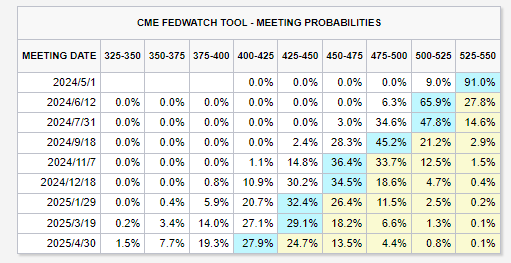Riding the Waves of the Fed's Dovish Stance: Seizing Investment Opportunities in US Treasuries
Despite market concerns before the meeting that the Federal Reserve would reduce the number of rate cuts this year to two, the dot plot indicates that the Fed still expects three rate cuts. The dot plot showed that the count of officials expecting three rate cuts this year has grown by three, now totaling nine. The median of the Fed officials' interest rate projections for this year remains unchanged from the last estimate, continuing to anticipate a reduction of 75 basis points.
Following the FOMC statement, according to the CME FedWatch Tool, the probability of a rate cut of 25 basis points by June has increased to 72.2%, from 58.79% a week ago, while The probability of a rate cut of at least 75 basis points is 76.3%, from 64.31% a week ago.

Wall Street Picks Up on Dovish Signals from March FED Meeting
Wall Street detects dovish tone from the March FED meeting due to some clues. 1) Powell admitted that recent inflation has been elevated but attributed early-year figures to seasonal influences, maintaining that inflation is trending downward. 2) Despite higher growth and inflation projections for late 2024, the Fed remains willing to maintain about three rate cuts within the year unchanged, suggesting a possibly lower threshold for easing.
Subadra Rajappa, Head of U.S. Rates Strategy at Société Générale, stated that despite strong economic growth and rising inflation, the Federal Reserve seems inclined to cut rates. The Fed appears to focus on the long-term inflation trend rather than month-to-month fluctuations and is willing to cut rates if inflation is moving in the right direction.
Sam Millette, Director of Fixed Income at Commonwealth Financial Network, suggests that the situation is largely the same as at the beginning of the year, and the Fed's anticipation of a rate cut sometime this year seems reasonable due to generally slower economic growth compared to last year.
"Powell was given the opportunity to adjust his language on Capitol Hill, which everybody took with starting in June, and he did not. And so, I was left more comfortable that they start in June," said Vincent Reinhart, Dreyfus and Mellon's chief economist, and a former top Fed economist.
Treasury Yield Curve Steepening: A Viable Strategy?
Following the Federal Reserve meeting, there may be a renewed enthusiasm for trading The Curve Steepener Trade. According to the CFA institute, Yield curve steepeners seek to gain from a greater spread between short- and long-term yields-to-maturity by combining a "long" short-dated bond position with a "short" long-dated bond position.
Due to the Federal Reserve's dovish stance, there is an increased likelihood of interest rate cuts this year, potentially leading to a decline in short-term interest rates. At the same time, an earlier rate cut could result in relatively higher inflation and interest rates in the longer term. This has brought trading The Curve Steepener back to the forefront
In other words, investors anticipate that when the Federal Reserve begins to cut interest rates, short-term bond yields will decline at a faster rate than long-term bond yields. As of the latest, the 10-year Treasury yield is about 35 basis points below the two-year yield. The gap was more than 100 basis points as recently as in July 2023.

Ashish Shah from Goldman Sachs Asset Management has expressed a continued preference before for steepener positions. He also mentioned that while inflation might not reduce in a straight line, it is generally on a downward trajectory.
Bill Gross, the co-founder of Pacific Investment Management Company (PIMCO) and renowned as the "Bond King", has also placed his bets on a steeper yield curve. Gross is anticipating that part of the interest-rate curve will return to a more normal pattern, which would eliminate the inversion that has persisted even following the Federal Reserve's cessation of interest rate hikes.

Is Long-Term U.S. Treasury Debt Worth Attention?
The market believes that long-term U.S. Treasury bonds are worth investing in as the demand for U.S. Treasuries has increased recently. Early this week, the U.S. Treasury's $13 billion auction of 20-year bonds saw unexpectedly strong demand, driving yields down. The bid-to-cover ratio hit 2.79, one of its highest, with indirect bidders—often foreign central banks—taking 73.5%, near a record and up from last month's 59.1%. Primary dealers received just 9.3%, one of the lowest shares on record, indicating robust real demand. This strength in demand, particularly for a typically less liquid 20-year bond, is a bullish signal for the market.
Similarly, the allocation for 30-year bonds to primary dealers this round was only 13.9%, the lowest since August of the previous year.
Moreover, investors poured over $1 trillion into money market funds, which invest in cash equivalents such as Treasury bills and commercial paper Last year. Since the start of this year, there has also been a consistent inflow into money funds.
Ed Al-Hussainy, a global rates strategist at Columbia Threadneedle Investments, states that the risk-reward of hoarding cash is no longer as compelling as it was during the surge in inflation and the Federal Reserve's rate hikes. "The marginal risk attached to the dollar invested in a cash fund today is very different," he said now that the Fed has signaled that interest rates have reached their peak. "Your reinvestment risk here is materially higher. Extending duration makes a lot of sense." Al-Hussainy suggests that bonds are attractive due to the more than doubling the 10-year Treasury yield over the past two years, offering more room to absorb potential capital losses.
Sources: Bloomberg, MarketWatch, Investopedia

Disclaimer: Moomoo Technologies Inc. is providing this content for information and educational use only.
Read more
Comment
Sign in to post a comment
